Spartan society, known for its military prowess and austere lifestyle, was structured in a rigid hierarchy. Understanding who held the highest status in Spartan society requires examining the various classes and their roles within this unique civilization. The highest position wasn’t simply about wealth or birth, but rather a combination of military leadership, civic duty, and adherence to Spartan ideals.
The Spartiates: The Ruling Elite
At the apex of Spartan society stood the Spartiates, also known as Homoioi meaning “equals” or “peers.” This elite class held all political power and dominated every aspect of Spartan life. Becoming a Spartiate wasn’t simply a matter of birthright. From a very young age, Spartan boys underwent rigorous training in the agoge, a brutal education system designed to mold them into fearless warriors. Only those who successfully completed this demanding program and proved their loyalty to the state could claim their place among the Spartiates.
The Spartiates dedicated their lives to military service and upholding the state’s strict laws. They were forbidden from engaging in trade or other manual labor, which were considered beneath their status. Instead, they focused solely on warfare and maintaining their physical and martial prowess. Their landholdings, worked by the helots, provided the resources necessary for their sustenance and freed them from the need to work, allowing them to concentrate on military training and governance.
The Perioeci: The Middle Class
Beneath the Spartiates were the Perioeci, a class of free, non-citizen inhabitants of Laconia and Messenia. They enjoyed certain freedoms and engaged in crafts, trade, and commerce, activities forbidden to the Spartiates. Though not possessing the same political rights as the Spartiates, the Perioeci played a vital role in the Spartan economy, providing essential goods and services. They also served in the Spartan army as auxiliary troops, supporting the Spartiate warriors. While they lacked the political power of the Spartiates, they enjoyed a degree of autonomy and were essential to the functioning of Spartan society.
The Helots: The Lowest Class
At the bottom of the Spartan social hierarchy were the helots, a subjugated population who worked the land owned by the Spartiates. Forced into servitude, the helots provided the agricultural labor that sustained the Spartan warrior class. They had no rights and were treated harshly, living under constant threat of violence and oppression. The Spartiates maintained a system of control and intimidation over the helots to prevent uprisings. This constant tension between the Spartiates and helots shaped Spartan society and its military focus.
 Spartan Social Hierarchy Pyramid
Spartan Social Hierarchy Pyramid
Who Held the Highest Status? A Deeper Look at Spartiate Ranks
Within the Spartiate class itself, there were further distinctions in status based on military rank, age, and achievement. Elderly Spartiates who had served with distinction held considerable influence within the Gerousia, the council of elders, which played a key role in Spartan government. The two kings, who served as both military and religious leaders, also held a position of high status. However, their power was checked by the ephors, five annually elected officials who oversaw the kings and held significant authority.
What Were the Responsibilities of the Highest Class?
The highest-ranking Spartiates held the most significant responsibilities in Spartan society. They led armies in battle, participated in the Gerousia, and served as ephors, shaping the political landscape. Maintaining their warrior ethos and upholding Spartan law were paramount. Their lives were dedicated to service to the state, and their status reflected this dedication.
Conclusion
In Spartan society, the Spartiates undoubtedly held the highest status. Their military prowess, political power, and adherence to the strict Spartan code elevated them above the Perioeci and the helots. Within the Spartiate class itself, status was further determined by factors like military rank, age, and civic contributions. Understanding this intricate social structure is crucial to understanding the complexities of ancient Sparta and its enduring legacy. The Spartiates’ position at the top of the hierarchy reflected the central role of warfare and discipline in Spartan culture.
FAQ
- Could Perioeci become Spartiates? Generally, no. Birthright and completion of the agoge were the primary requirements for Spartiate status.
- Did helots ever revolt? Yes, there were several helot revolts throughout Spartan history, reflecting the inherent instability of the social system.
- Who were the ephors? The ephors were five annually elected officials who held significant power and oversight over even the Spartan kings.
- What was the agoge? The agoge was the rigorous training and education system that Spartan boys underwent to become warriors.
- What was the role of women in Spartan society? Spartan women had more freedom and responsibilities than women in other Greek city-states, primarily focused on managing households and raising strong Spartan children.
- What happened to Spartiates who failed the agoge? They lost their Spartiate status and became part of a lower class, often similar to the Perioeci.
- Were the kings always the highest authority in Sparta? No, the ephors and the Gerousia held considerable power and could check the authority of the kings.
Related Articles
- The Spartan Agoge: Shaping Warriors
- The Role of Women in Ancient Sparta
- The Perioeci: A Closer Look at Spartan Crafts and Trade
Need more support? Contact us 24/7: Phone: 02043854663, Email: [email protected], Address: Khu 34, Bac Giang, 260000, Vietnam.